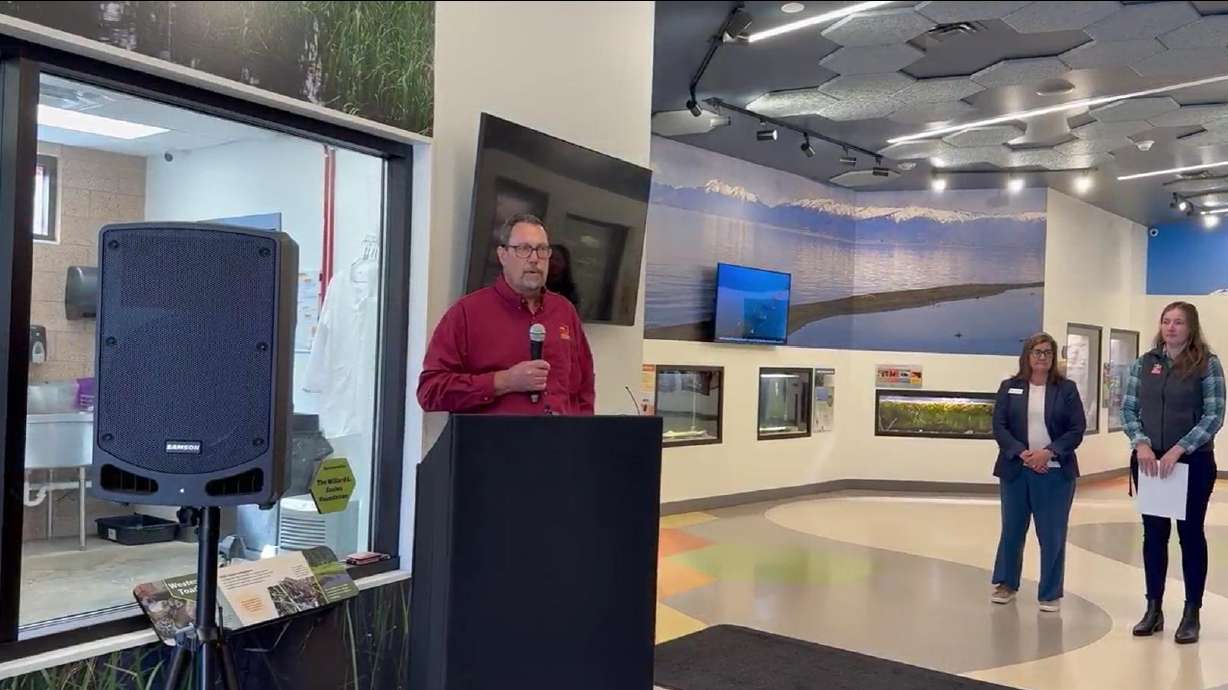SALT LAKE CITY — Over 250 species are identified as at-risk species in Utah, and conservationists say anyone in the state can get involved to help protect them.
The Utah Wildlife Action Plan is the blueprint for conserving the state’s native species, providing a framework to help keep them off the federal endangered species list. The Utah Wildlife Action Plan is being revised for 2025, as its most recent version was created in 2015. The plan is updated every decade to ensure that at-risk species and their habitats receive the necessary conservation efforts for the survival of these species.
“We’re here to celebrate today the power of partnerships and engaging our community statewide to help care for and conserve the amazing wildlife we have here in Utah,” said Liz Larsen, chief mission officer at Utah’s Hogle Zoo, speaking Tuesday at the Aline W. Skaggs Wild Utah exhibit at Hogle Zoo.
Conservation Director Isobel Lingenfelter, of the Utah Wildlife Federation, announced that species like the Bonneville cutthroat trout and the American bald eagle all share a history of recovery thanks to the partnership and science guiding the Wildlife Action Plan.
The exhibit features the Norma W. Matheson Education Animal Center, home of the Western Toad Conservation Program, which includes a successful breeding colony.
The Western toad is one of the species prioritized in the Wildlife Action Plan that has seen a serious population decline over the last two decades. In 2008, the Hogle Zoo, along with two other zoos, stepped in to breed the toads. In 2022, 1,900 toads were released into their native habitat on the Paunsaugunt Plateau.
The primary threats to the Western toad in Utah include habitat degradation from development, drought, and water management, but the major contributing factor is a deadly disease called the chytrid fungus disease.
“It attacks the skin of amphibians, and they aren’t able to regulate their respiration and kind of how they regulate their bodies because of this fungus that can attach to their skin,” said Keilani Fang, field conservation programs coordinator at the Hogle Zoo.
According to Fang, it is nearly impossible to cure a pond of the disease, but they can take steps to ensure the disease does not spread to other ponds.
The program encourages the public to participate in conservation efforts. Volunteers are trained to assist in field surveys to collect data on the toads’ distribution, size and habitat.
“So what I do is I train volunteers on how to collect data on these species of greatest conservation need, such as Western toads, and then you can come out with me in the field. We’ll hike to stunning mountain wetlands, places where we know toads are, where we think they might be, or places that just haven’t had the exploration and time dedicated to them to understand the species distribution,” Fang said.
Of the 250 species, the plan includes eight herps, 22 fish, 26 mollusks, 14 mammals, 23 birds, 145 plants and 16 insects. The plan aims to protect some of the most iconic Utah species, including the gila monster, cutthroat trout, Utah prairie dog, snowy plover, and pygmy rabbit.
Paul Thompson, the habitat section assistant chief for the Utah Division of Wildlife Resources, emphasized the top contributing factors to the population declines in all the species. While every species is unique in what causes decline in its population, they all share common contributing factors.
“We live in the third driest state in the nation, and if you add extended drought to that, water is more scarce on the landscape, so it impacts population development,” said Thompson. “We’re growing, so we got to really be, we got to be working with developers, letting them understand where we have these conflicts, and try to work through those so that we can have wins and have development and still keep these species on our landscape.”
The public is invited to attend the Utah Wildlife Summit on Oct. 18 at 10 a.m. at Utah’s Hogle Zoo to learn how they can contribute to the next decade of success for Utah’s wildlife. For more information, visit secure.qgiv.com/for/utahwildlifefederation/event/utahwildlifesummit/.
The Key Takeaways for this article were generated with the assistance of large language models and reviewed by our editorial team. The article, itself, is solely human-written.

